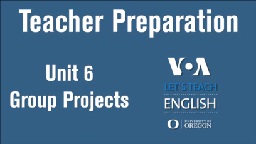 Video Transcript Video Transcript
Narrator: In this lesson, the teacher gives students the responsibility of
choosing a
project and organizing themselves into groups. The information students
need for their role-plays is on cards they read and discuss. |
|
|
Teacher: In our last class, we learned about eating in a restaurant. Let’s
use our
role cards again. You can choose your group projects. Julia, please read
the choices.
Julia: Open a restaurant. Eat in a restaurant.
Teacher: Good. Mimi, please open the card with number 1 and read it.
Mimi: To open a restaurant, come to this table.
Teacher: Good. Emma, number 2.
Emma: To eat at a restaurant, come to this table.
Teacher: Okay, please stand up and choose now.
(Students stand and move to their choice of group project.)
Teacher: Emma, is there another card on the table?
Emma: Yes. Everyone, take a group role card.
(Students each take a role card.)
Teacher: Good. And what about this table?
Maryam: (Maryam reads a card.)
Remember, everyone in the group helps. And have fun!
Teacher: Okay. Any questions? Maryam.
Maryam: How much time do we have?
Teacher: You have twenty minutes. Other questions? Julia.
Julia: How long is our role play?
Teacher: Your role play is from two to five minutes. Okay. I’ll start the
timer now.
(The teacher starts the timer on her phone.)
Narrator: As the students work in groups, they have several creative writing
tasks.
One group chooses a name, creates a menu, and writes an advertisement
for their restaurant. The other group writes a dialogue about ordering food
and paying the bill.
(Students work on their restaurant group projects.)
Julia: We need a name for our restaurant.
Emma: I like natural food. Um, how about "Blue Natural”?
Julia: What kind of food do we have?
Emma: Greek food: um, hummus, pita, feta, olives, . . .
Maryam: I am a customer.
Mimi: I am the owner.
Teacher: Two minutes left. Please finish your work soon.
(Students continue to work on their projects.)
Teacher: Okay, class, time’s up!
All: Five, four, three, two, one.
(The teacher holds up her hand and counts backward on her fingers as a
way to call students to attention. The students join her and count
backwards on their hands too.)
Teacher: Are you ready?
Students: Yes!
Teacher: Good!
Teacher: This group, please come up and do your role-play.
(The teacher gestures to the group on her left.)
Teacher: This group, listen carefully. Answer the questions about their
role-play with
your checklist.
(The teacher gestures to the group on her right.)
(Emma and Julia stand at the front of the class and hold up their menu
and advertisement.)
Emma: We are opening a restaurant.
Julia: Here is our advertisement. “The Blue Natural – Now Open.”
Emma: This restaurant serves Greek food. All our food is natural. Here’s our
menu.
Julia: We have hummus and pita and salad and meat . . .
(Julia points to each menu item as she reads it.)
(As one group performs the role play, the other students answer their
questions on their checklists.)
Teacher: Group 2, come up.
(Group 2 stands and goes to the front of the class.)
Mimi: We are eating at a restaurant. We like the Bob’s Coffee Shop menu. I
am
the owner.
Maryam: I am the customer.
Mimi: Welcome! Please have a seat.
Maryam: Thank you.
(Maryam sits down and Mimi passes her the menu.)
Mimi: Here is the menu . . .
Maryam: Thank you.
Mimi: The french fries are really, really good, and they're ninety-nine
cents, so . . .
Teacher: Okay. Great work. Thank you. You can have copies of these
checklists in
your next class. Okay, thank you . . .
(The teacher collects the checklist from the students.)
Narrator: Summary: Reading the instructions for the group work and finishing
it
independently can give learners more confidence in their ability to use
English. In addition, the cooperative learning cards also help guarantee
that everyone does an equal part in group work. Next time, join us for Unit
7. We will teach critical thinking skills. |
|
Group Projects Instructions
A. Open a restaurant
1. You are opening a new restaurant. What is the name of the restaurant?
2. In your small group, choose five dishes to include on the menu.
3. Write a menu. Find or draw pictures of the dishes to put on the menu.
4. Write an advertisement for your restaurant. Tell people why it is
special.
B. Eat in a restaurant
1. Get a copy of a menu (from a local restaurant, the web, or write your
own).
2. In a small group, write a short dialogue about ordering food and paying
the bill.
3. Role-play your dialogue for the group.
4. Put your menus and dialogues together in a book or post them on a
Facebook
page.
© 2017 University of Oregon and Voice of America. This work is based on the
Women Teaching Women English materials
produced by the University of Oregon American English Institute under U.S.
Department of State Federal Assistance Award
S-LE200-10-GR-050, issued by the U.S. Embassy Beirut. |
|